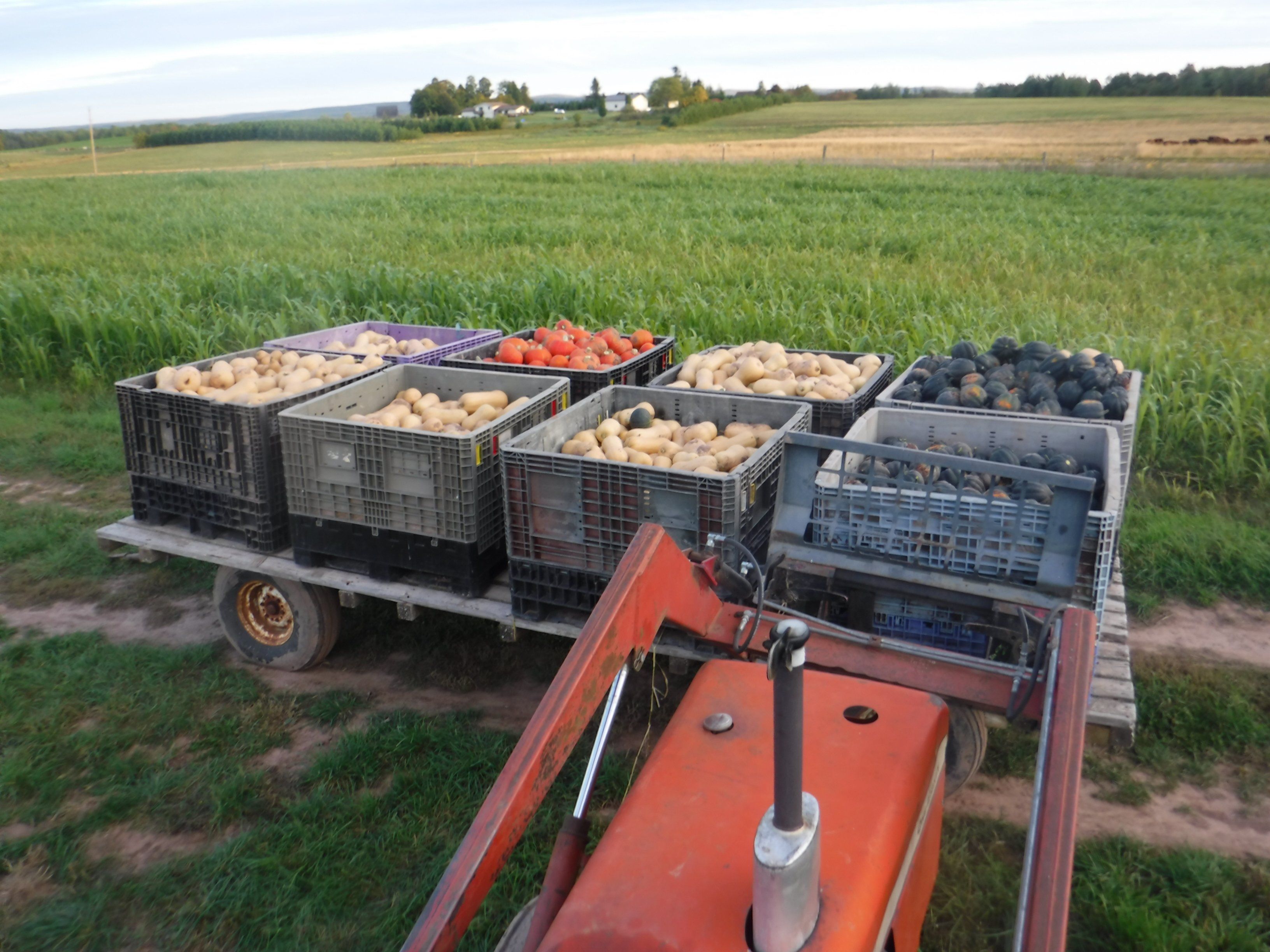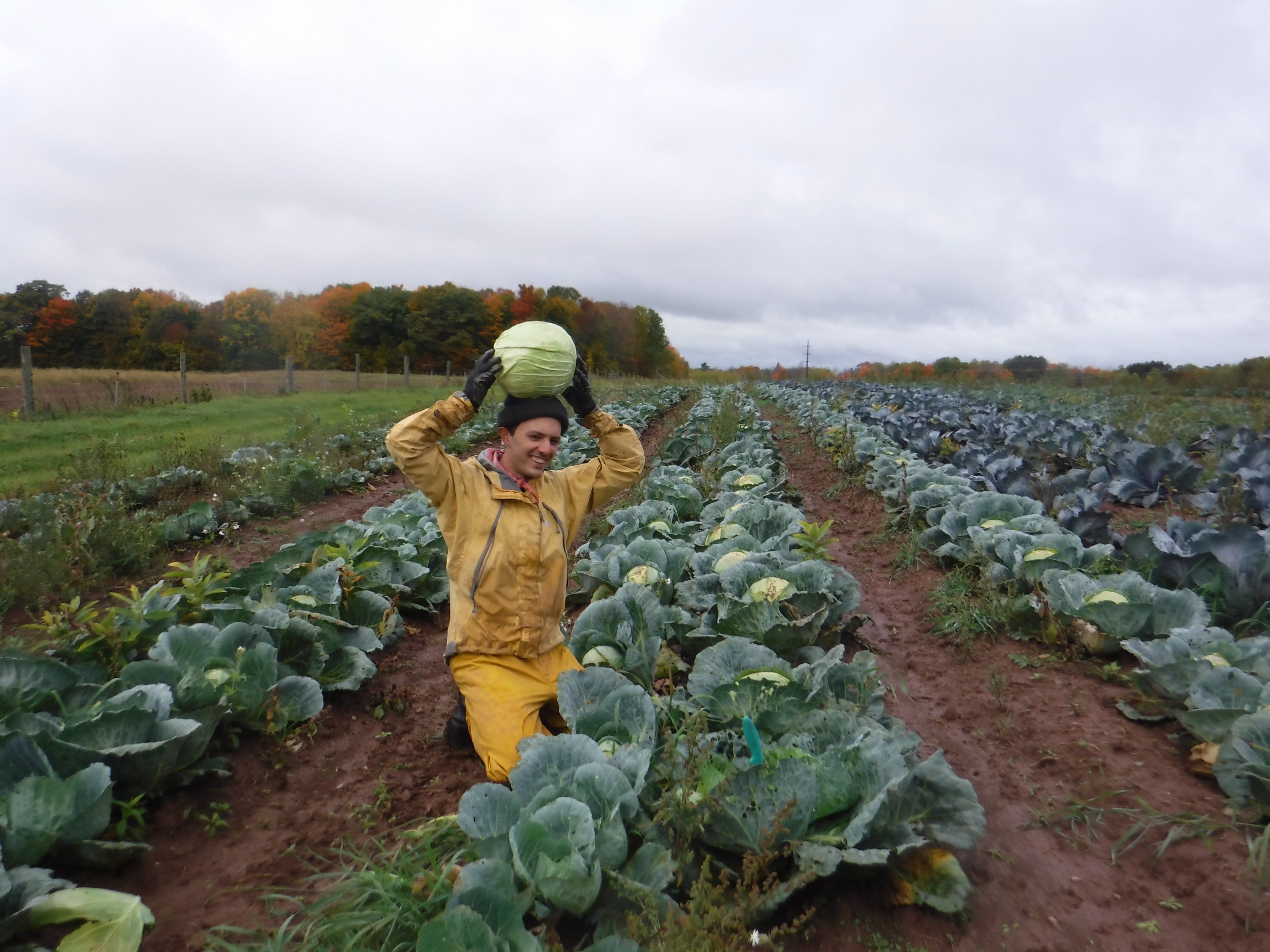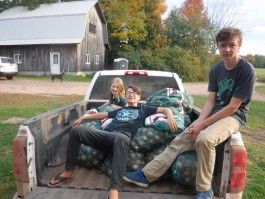Happy Fall! As the seasons change, so too will the variety of veggies available in your boxes. This is one of my favorite parts of seasonal eating and farming. In the end, the weather is what dictates what's for dinner, which keeps our menus interesting over the course of the year. The weather seems far from "wintery" now, but the cold temps will be back before we know it, and we've been working hard to keep bringing in the harvests for storage. This week after their school work was completed, the kids helped me bag up and haul the last of the onions to the greenhouse. I told them this was their gym class, combined with driver's ed for our middle son, who got to drive the truck through the field as we loaded the sacks in the back. Those mesh sacks of onions will continue to dry down for a few weeks on racks in the greenhouse, then we'll move them into a storage room in the garage for winter.
Winter squash harvest continues, and in case you might be rusty on your winter squash identification, you can reference the picture above and these descriptions to help you choose what squash you might like to enjoy each week. Starting on the left, you'll see the iconic dark green acorn squash with the yellow/gold mark indicating ripeness. These squash are not as sweet as others, and lend themselves to savory cooking. On average, they weigh in about 2.5-3.5# each. Stuffed acorn squash with wild rice, sausage, apples, onions, and celery is a big hit in our house. But for a simpler preparation, you can simply slice them into "smiles" (scoop out the seeds, and leave the skin on) and coat with olive oil, salt and pepper. Roast in the oven at about 400 until they begin to brown on the bottom, then turn and brown on the other side. This olive oil prep is an easy way to use any squash - it's quick, easy, and SO good. To the right of the acorn squash is the yellow striped delicata squash. They usually weigh about a pound each, and are a sweeter squash. Roasting with olive oil is our favorite way to prepare them, but they are another great option for stuffing. Next in line are the grey kobacha and red kuri squashes, with characteristic corky brown stems. The grey kobacha tend to taste better after longer storage, while the red kuri are fine eating early in the fall. Both have sweet dry flesh inside. Finally you probably recognize the brown, pear shaped butternut squash, which typically weigh between 4 and 6 pounds. These butternuts have been curing for a week already, but flavor will continue to improve the longer they are stored. Squash are pretty forgiving to store in your house - just keep them on the counter and they will last for weeks. Ideally, they like 55 degrees with about 55% humidity for longer term storage. And for an extra treat, with any of these squash you can roast the seeds with oil and salt/pepper in the oven as well.
One crop that really shines in the fall is broccoli, and as you can see behind me in the pic above our fall broccoli field looks top notch! Broccoli selfie time :) Frost sweetens the plants as they concentrate sugars to prevent cold damage, and fall broccoli just can't be beat. The broccoli plants (and your farmers as well!) have been loving the mild, dry weather this past week. Last year, we were slogging ankle deep in mud harvesting fall broccoli and winter squash with winter hats and long johns. Meanwhile, it has been over 80 degrees and sunny here at the farm this week. If anything, this warm spell has been pushing our fall broccoli plantings to come ready all at once. To take advantage of the big fall broccoli harvest, for the next several weeks we'll be offering bulk 20# cases of broccoli if you'd like to get some put away in the freezer for winter. Freezing broccoli is a breeze (and your winter self will thank you later!) Just bring a pot of water to a boil, drop your chopped up broccoli florets in, cover, and set the timer for 2 minutes. After blanching in the hot water they will begin to turn bright green, but will still be a little firm. When the timer goes off, cool in a sink of cold water, then bag up in quart bags and freeze.

Meanwhile, in the hoophouses, we've been taking out summer crops and seeding more spinach. This hot weather unfortunately caused our first planting of fall spinach to bolt (or shoot up a seed stalk, which makes the leaves bitter). To help keep the crop cooler in this warm weather, we've been overhead irrigating the spinach during the hottest part of the day, and evaporative cooling seems to be working - the next rounds of spinach will be ready to harvest for your boxes this week. Here you can see farmers Ryan (near) and Eric prepping beds that used to be growing basil and the early bolted spinach for a new round of spinach that we seeded earlier this week. We also have begun taking down the slicer tomatoes, and will be prepping those beds for spinach next week once all the plants are removed. Goodbye, summer... Hello, spinach!
Outside, the cover crops that we've seeded (vetch - the frilly little legume seedling in between my fingers above, and rye -the grass growing next to it) are growing nicely. They will continue to grow all fall and keep our soil protected and biologically active through the winter and into next spring. After the final harvest of sweet corn last week, I mowed down the last patch of corn stalks, and was amazed at how successful our experiment to establish clover as a cover crop under the corn turned out. This summer, just as our last planting of corn got too tall to get over with the tractor to control weeds, we broadcast red clover over the entire planting. Then farmer Eric cultivated lightly, which knocked back the next round of weeds and "planted" the clover under a little bit of soil. The clover grew slowly in the understory of the corn all summer, and now that the corn is mowed down, the whole field is a great looking stand of clover! As nerdy biological farmers, this is the kind of stuff we get really pumped about... Being able to grow a veggie crop (corn) AND a cover crop (clover - a nitrogen fixing legume) in the same field simultaneously is fantastic! A crop to feed the people, and a crop to feed the soil - definitely a win-win! In the pic below, you can see the clover growing through the corn stubble on the bottom left (no bare dirt for winter there - horay!) and a few other fields greening up with a carpet of young rye and vetch below two of our hoophouses.
One final reminder - your summer CSA boxes will continue until the end of October. If you'd like to keep the good stuff coming all winter long, consider signing up for a winter CSA box, which run twice a month now from November through March! Along with all the great meat and value added products, we'll have lots of great storage veggies and winter greens available, as well as some frozen veggies that Karra has been putting up for you in kitchen of the Bayfield Apple Company. On behalf of all the farmers and producers in our Bayfield Foods Cooperative, we are incredibly grateful for your support of local foods, and it's an honor to be working with you.
Enjoy this gorgeous fall weather!
In community,
Farmer Chris
Great Oak Farm








